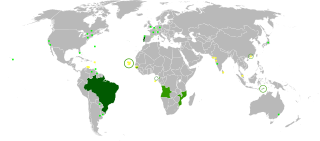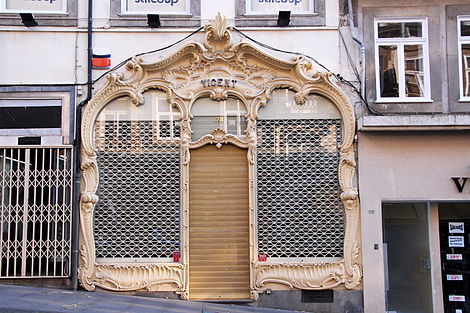| Vincent House | |
|---|---|
Casa Vicent | |
 The front facade of Casa Vicent, comparable to the front facade of the Café Majestic | |
| General information | |
| Type | Commercial Shop |
| Architectural style | Rococo |
| Location | Santo Ildefonso |
| Country | |
| Coordinates | 41°8′46″N8°36′30″W / 41.14611°N 8.60833°W Coordinates: 41°8′46″N8°36′30″W / 41.14611°N 8.60833°W |
| Opened | 20th century |
| Technical details | |
| Material | Iron |
| Design and construction | |
| Architect | Companhia Aliança |
Casa Vicent is a historic building in the civil parish of Santo Ildefonso, in the Portuguese city of Porto. Located in the historic lower town (Portuguese : Baixa), the shop is notable for the Art Nouveau and Rococo elements and undulating forms of its iron facade; it is similar to the facades of the Ourivesaria Cunha and Ourivesaria Reis along the same road, all constructed by the Companhia Aliança.

Portugal, officially the Portuguese Republic, is a country located mostly on the Iberian Peninsula in southwestern Europe. It is the westernmost sovereign state of mainland Europe, being bordered to the west and south by the Atlantic Ocean and to the north and east by Spain. Its territory also includes the Atlantic archipelagos of the Azores and Madeira, both autonomous regions with their own regional governments.

Porto, also known as Oporto in some languages,is the second-largest city in Portugal, one of the Iberian Peninsula's major urban areas, famous for Port wine and soccer team FC Porto. Porto city has a population of 287,591 and a metropolitan area with 2.3 million people (2011) in an area of 2,395 km2 (925 sq mi), making it the second-largest urban area in Portugal. It is recognized as a gamma-level global city by the Globalization and World Cities (GaWC) Study Group, the only Portuguese city besides Lisbon to be recognised as a global city.

Portuguese is a Western Romance language originating in the Iberian Peninsula. It is the sole official language of Portugal, Brazil, Cape Verde, Guinea-Bissau, Mozambique, Angola and São Tomé and Príncipe. It also has co-official language status in East Timor, Equatorial Guinea and Macau in China. As the result of expansion during colonial times, a cultural presence of Portuguese and Portuguese creole speakers are also found in Goa, Daman and Diu in India; in Batticaloa on the east coast of Sri Lanka; in the Indonesian island of Flores; in the Malacca state of Malaysia; and the ABC islands in the Caribbean where Papiamento is spoken, while Cape Verdean Creole is the most widely spoken Portuguese-based Creole. A Portuguese-speaking person or nation is referred to as "Lusophone" (Lusófono).



















